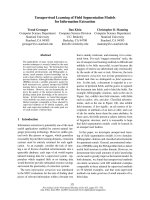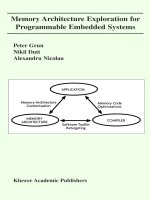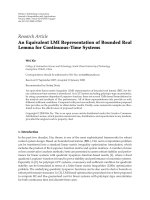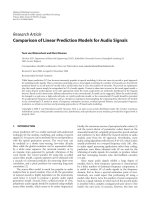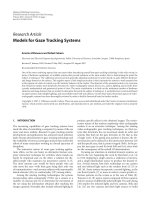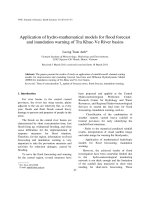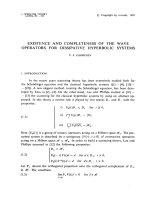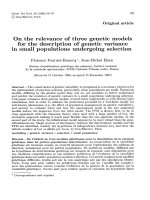Parameterized validation of UML like models for reactive embedded systems
Bạn đang xem bản rút gọn của tài liệu. Xem và tải ngay bản đầy đủ của tài liệu tại đây (2.37 MB, 322 trang )
PARAMETERIZED VALIDATION OF
UML-LIKE MODELS FOR REACTIVE
EMBEDDED SYSTEMS
ANKIT GOEL
(B.Tech. (Hons.), IT-BHU, India)
A THESIS SUBMITTED
FOR THE DEGREE OF DOCTOR OF PHILOSOPHY
DEPARTMENT OF COMPUTER SCIENCE
NATIONAL UNIVERSITY OF SINGAPORE
2009
ii
Acknowledgments
I would like offer my deep a nd sincere gratitude to my supervisor, Dr. Abhik R oy-
choudhury, for his constant support a nd guidance during the course of this work. He
was always available for discussions, providing with insightful comments and ideas,
that have played an important role in maintaining the focus and progress of this
research.
I owe my sincere thanks to Professor P. S. Thiagarajan, for providing me with
a rich learning experience in all the interactions I had with him. There was a lways
something to learn from his deep insight and experience. His various comments and
suggestions have played a crucial role during the course of my research.
I want to thank Dr. Jin Song Dong, who has been a member of my thesis com-
mittee, for his thought provoking comments and suggestions during my var io us pre-
sentations. I would also like to thank Dr. Tulika Mitra for providing me with the
initial opportunity to visit School of Computing, National University of Singapore,
and get a taste of some serious research. I am thankful to various lab-mates I have
had during the course of my research, who have been there as companions, providing
warmth, support and funny moments throughout.
I gratefully acknowledge the financial support I received during my research from
School of Computing, National University of Singapo r e. It also provided me with
excellent opportunities to at tend various conferences overseas.
Finally, it has been the continuous support, endless patience, encouragement and
love of my parents, which kept me motivated to continue and finish this work. Special
thanks are also due to my younger brother Achin, for his love and support.
CONTENTS iii
Contents
I Introduction 1
1 Introduction 3
1.1 The Problem Addressed in this work . . . . . . . . . . . . . . . . . . 5
1.2 Solution Propo sed in this dissertation . . . . . . . . . . . . . . . . . . 7
1.3 Contributions of t his thesis . . . . . . . . . . . . . . . . . . . . . . . . 9
1.4 Organization of the Thesis . . . . . . . . . . . . . . . . . . . . . . . . 11
II M odeling Notations 12
2 Related Work 13
2.1 State-based models . . . . . . . . . . . . . . . . . . . . . . . . . . . . 14
2.2 Scenario-based Models . . . . . . . . . . . . . . . . . . . . . . . . . . 17
2.2.1 Analysis of MSC Specifications . . . . . . . . . . . . . . . . . 19
2.2.2 Realizability and Implied Scenarios . . . . . . . . . . . . . . . 20
2.2.3 Scalability of MSC Specifications . . . . . . . . . . . . . . . . 22
2.2.4 Other Notations . . . . . . . . . . . . . . . . . . . . . . . . . . 23
2.3 Parameterized System Verification . . . . . . . . . . . . . . . . . . . . 24
2.4 Model Checking and Data Abstraction . . . . . . . . . . . . . . . . . 26
2.5 The Semantics of a Class . . . . . . . . . . . . . . . . . . . . . . . . . 27
3 Interacting Process Classes (IPC) 29
iv CONTENTS
3.1 The Modeling Language . . . . . . . . . . . . . . . . . . . . . . . . . 30
3.2 Modeling A Rail-Car System: The First-Cut . . . . . . . . . . . . . . 35
3.3 Concrete Execution Semantics . . . . . . . . . . . . . . . . . . . . . . 39
3.4 Abstract Execution Semantics . . . . . . . . . . . . . . . . . . . . . . 44
3.4.1 Abstract Execution of Core Model . . . . . . . . . . . . . . . 45
3.4.2 Dynamic Process Creation/Deletion . . . . . . . . . . . . . . . 52
3.5 Associations . . . . . . . . . . . . . . . . . . . . . . . . . . . . . . . . 53
3.5.1 Modeling Static and Dynamic Associations . . . . . . . . . . . 55
3.5.2 Concrete execution of IPC models with associations . . . . . . 56
3.5.3 Abstract execution of IPC models with associations . . . . . . 60
3.6 Exactness of Abstract Semantics . . . . . . . . . . . . . . . . . . . . . 64
3.6.1 Over-Approximation Results . . . . . . . . . . . . . . . . . . . 64
3.6.2 Spurious abstract executions . . . . . . . . . . . . . . . . . . . 66
3.6.3 Detecting spurious abstract executions . . . . . . . . . . . . . 70
3.7 Experiments . . . . . . . . . . . . . . . . . . . . . . . . . . . . . . . . 73
3.7.1 Modeled Examples . . . . . . . . . . . . . . . . . . . . . . . . 73
3.7.2 Use Cases . . . . . . . . . . . . . . . . . . . . . . . . . . . . . 76
3.7.3 Timing and Memory Overheads . . . . . . . . . . . . . . . . . 78
3.7.4 Checking for spurious execution runs . . . . . . . . . . . . . . 79
3.7.5 Debugging Experience . . . . . . . . . . . . . . . . . . . . . . 80
3.8 Discussion . . . . . . . . . . . . . . . . . . . . . . . . . . . . . . . . . 83
4 Symbolic Message Sequence Charts (SMSC) 85
4.1 Syntax . . . . . . . . . . . . . . . . . . . . . . . . . . . . . . . . . . . 90
4.1.1 Visual Syntax . . . . . . . . . . . . . . . . . . . . . . . . . . . 90
4.1.2 Abstract Syntax . . . . . . . . . . . . . . . . . . . . . . . . . . 93
4.2 CTAS Case Study . . . . . . . . . . . . . . . . . . . . . . . . . . . . . 98
4.3 Process Theory . . . . . . . . . . . . . . . . . . . . . . . . . . . . . . 102
4.3.1 Configurations . . . . . . . . . . . . . . . . . . . . . . . . . . . 103
CONTENTS v
4.3.2 Semantic Rules and Bisimulation . . . . . . . . . . . . . . . . 104
4.4 Execution Semantics for SMSCs . . . . . . . . . . . . . . . . . . . . . 110
4.4.1 Translating SMSCs to process terms . . . . . . . . . . . . . . 111
4.4.2 Concrete Execution Semantics . . . . . . . . . . . . . . . . . . 112
4.4.3 Example Illustrating Concrete Execution . . . . . . . . . . . . 11 8
4.4.4 Abstract Execution Semantics . . . . . . . . . . . . . . . . . . 119
4.4.5 Example Illustrating Abstract Execution . . . . . . . . . . . . 125
4.4.6 Properties of SMSC Semantics . . . . . . . . . . . . . . . . . . 126
4.5 Experiments . . . . . . . . . . . . . . . . . . . . . . . . . . . . . . . . 128
4.6 Asso ciations . . . . . . . . . . . . . . . . . . . . . . . . . . . . . . . . 132
4.6.1 Case Study– A Course Management System . . . . . . . . . . 133
4.6.2 Asso ciation constraints . . . . . . . . . . . . . . . . . . . . . . 135
4.7 Abstract execution semantics with Associations . . . . . . . . . . . . 138
4.7.1 Asso ciation Insert . . . . . . . . . . . . . . . . . . . . . . . . . 141
4.7.2 Asso ciation Check/Delete . . . . . . . . . . . . . . . . . . . . 147
4.7.3 Default case . . . . . . . . . . . . . . . . . . . . . . . . . . . . 153
4.8 Exactness of Abstract Semantics . . . . . . . . . . . . . . . . . . . . . 154
4.9 Spurious abstract executions . . . . . . . . . . . . . . . . . . . . . . . 156
4.10 Associations with Asynchronous semantics . . . . . . . . . . . . . . . 158
4.11 Discussion . . . . . . . . . . . . . . . . . . . . . . . . . . . . . . . . . 16 0
5 A comparative study of IPC and SMSC notations 163
5.1 Local vs Global control . . . . . . . . . . . . . . . . . . . . . . . . . . 163
5.2 Granularity of Execution . . . . . . . . . . . . . . . . . . . . . . . . . 164
5.3 Lifeline Abstraction . . . . . . . . . . . . . . . . . . . . . . . . . . . . 165
5.4 Asso ciations . . . . . . . . . . . . . . . . . . . . . . . . . . . . . . . . 167
5.5 Types of Requirements Documents . . . . . . . . . . . . . . . . . . . 168
5.5.1 Requirements capturing overall system scenarios via MSCs . . 16 9
5.5.2 Requirements describing system behavior as global constraints 170
vi CONTENTS
III Model-based Test Generation 173
6 Introduction 175
6.1 Related Work . . . . . . . . . . . . . . . . . . . . . . . . . . . . . . . 177
6.2 State-based . . . . . . . . . . . . . . . . . . . . . . . . . . . . . . . . 177
6.3 Scenario-based . . . . . . . . . . . . . . . . . . . . . . . . . . . . . . 179
6.4 Combined notations . . . . . . . . . . . . . . . . . . . . . . . . . . . . 179
6.5 Symbolic Test Generation . . . . . . . . . . . . . . . . . . . . . . . . 1 80
7 Test Generation from IPC 181
7.1 Case Study – MOST . . . . . . . . . . . . . . . . . . . . . . . . . . . 183
7.2 Meeting Test Specifications . . . . . . . . . . . . . . . . . . . . . . . 190
7.2.1 Problem Formulation . . . . . . . . . . . . . . . . . . . . . . . 1 90
7.2.2 A
∗
search . . . . . . . . . . . . . . . . . . . . . . . . . . . . . 191
7.2.3 Test generation Algorithm . . . . . . . . . . . . . . . . . . . . 195
7.3 Experimental Results . . . . . . . . . . . . . . . . . . . . . . . . . . . 1 97
8 Test Generation from SMSC 203
8.1 Test-purpose specification . . . . . . . . . . . . . . . . . . . . . . . . 206
8.1.1 CTAS Case Study . . . . . . . . . . . . . . . . . . . . . . . . . 207
8.1.2 Test-purpose Specification . . . . . . . . . . . . . . . . . . . . 210
8.2 Test Generation Overview . . . . . . . . . . . . . . . . . . . . . . . . 2 13
8.2.1 Deriving abstract test case SMSC . . . . . . . . . . . . . . . . 213
8.2.2 Deriving templates . . . . . . . . . . . . . . . . . . . . . . . . 215
8.2.3 Deriving concrete tests . . . . . . . . . . . . . . . . . . . . . . 222
8.3 Test Generation Method . . . . . . . . . . . . . . . . . . . . . . . . . 223
8.3.1 Abstract test-case generation . . . . . . . . . . . . . . . . . . 223
8.3.2 Template generation . . . . . . . . . . . . . . . . . . . . . . . 229
8.3.3 Concrete test case generation . . . . . . . . . . . . . . . . . . 238
8.3.4 Summary . . . . . . . . . . . . . . . . . . . . . . . . . . . . . 2 42
CONTENTS vii
8.4 Test-execution Setup . . . . . . . . . . . . . . . . . . . . . . . . . . . 242
8.5 Experiments . . . . . . . . . . . . . . . . . . . . . . . . . . . . . . . . 247
8.5.1 Test generation . . . . . . . . . . . . . . . . . . . . . . . . . . 247
8.5.2 Portability . . . . . . . . . . . . . . . . . . . . . . . . . . . . . 251
8.5.3 Test execution . . . . . . . . . . . . . . . . . . . . . . . . . . . 25 2
8.6 Discussion . . . . . . . . . . . . . . . . . . . . . . . . . . . . . . . . . 259
IV Conclusion 260
9 Conclusions and Future Work 261
9.1 Future Work . . . . . . . . . . . . . . . . . . . . . . . . . . . . . . . . 263
9.1.1 Extensions . . . . . . . . . . . . . . . . . . . . . . . . . . . . . 263
9.1.2 Tool Support . . . . . . . . . . . . . . . . . . . . . . . . . . . 265
9.1.3 Applications . . . . . . . . . . . . . . . . . . . . . . . . . . . . 266
A IPC 287
A.1 Proof of Theorem 1 . . . . . . . . . . . . . . . . . . . . . . . . . . . . 287
A.2 Checking spuriousness of execution runs in Murphi . . . . . . . . . . 293
B IPC Test generation Algorithm genTrace 297
C SMSC 301
C.1 Proof of Theorem 7 . . . . . . . . . . . . . . . . . . . . . . . . . . . . 301
viii ABSTRACT
ABSTRACT ix
Abstract
Distributed reactive systems consisting of classes of behaviorally similar interacting
processes arise in various application domains such as telecommunication, avionics
and automotive control. For instance, a telecommunication network with thousands
of interacting phones (constituting a phone class), or a controller managing hundreds
of clients requiring latest weather information in an air-traffic control system. Various
existing modeling notations, such as those included in the UML standard (e.g. State-
machines and Sequence diagrams), are not well equipped for requirements modeling of
such systems, since they assume a fixed number of processes in the system. Moreover,
in the behavioral analysis of requirements modeled using these notations (a) various
processes are dealt with in a concrete manner leading to scalability issues, and (b)
the inter-class associations are often not taken into account.
Message Sequence Charts (MSCs) and its variants such as UML Sequence-diagrams
are popular not ations for modeling scenario-based requirements, capturing interac-
tions among various processes in the system. In this thesis, we develop two UML-like
executable modeling notations based o n MSCs for parameterized validation of dis-
tributed reactive systems consisting of classes of interacting processes. These nota-
tions are– (i) Interacting Process Classes (IPC), and (ii) Symbolic Message Sequence
Charts (SMSC), respectively. We propo se an a bstract execution semantics for both
these notations, where we dynamically group together objects at runtime that will
have similar future behaviors. We also capture static and dynamic association links
between objects, and use class diagrams in a standard way to specify binary inter-
class associations. Finally, we study automated test-generation techniques from our
x ABSTRACT
modeling notations. The test-cases generated from our MSC-based models provide a
crucial link by enabling testing of final implementation with respect to the original
requirements.
LIST OF TABLES xi
List of Tables
3.1 Process Classes & Object counts in Rail-car Example with 48 cars . . 37
3.2 Maximum no. of partitions observed during abstract simulation . . . 75
3.3 Timing/Memory Overheads of Concrete vs. Abstract Execution . . . 77
4.1 Operational Semantics f or Constants . . . . . . . . . . . . . . . . . . 105
4.2 Operational Semantics f or Delayed Choice ∓ . . . . . . . . . . . . . . 105
7.1 Test generation results . . . . . . . . . . . . . . . . . . . . . . . . . . 198
8.1 Extended-states reachable during template generation. . . . . . . . . 234
8.2 Symbolic Test Generation for CTAS example . . . . . . . . . . . . . . 248
8.3 Structural information: (S)MSC-based models for CTAS. . . . . . . . 251
8.4 Comparing test generation times for (S)MSC based approaches. . . . 252
8.5 Key features of the CM’s Statechart. . . . . . . . . . . . . . . . . . . 253
8.6 Use of our generated concrete tests for bug detection. . . . . . . . . . 257
xii LIST OF TABLES
LIST OF FIGURES xiii
List of Figures
2-1 An example MSC. . . . . . . . . . . . . . . . . . . . . . . . . . . . . 18
3-1 Transactions departReqA & noMoreDe st . . . . . . . . . . . . . . . . 32
3-2 Rail-car system . . . . . . . . . . . . . . . . . . . . . . . . . . . . . . 36
3-3 Terminal . . . . . . . . . . . . . . . . . . . . . . . . . . . . . . . . . . 36
3-4 Fra gment of Labeled Transition Systems for the Rail-car example . . 54
3-5 Class diagram for Rail-car example. . . . . . . . . . . . . . . . . . . . 56
3-6 Dynamic Relation itsTerminal . . . . . . . . . . . . . . . . . . . . . . 59
3-7 Example illustrating spurious runs . . . . . . . . . . . . . . . . . . . . 67
3-8 Execution Time and Memory usage for the Rail-car example . . . . . 79
3-9 Snippet of Transition System for Weather-Update Controller . . . . . 83
4-1 An MSC showing processor read r equest over a shared bus . . . . . . 86
4-2 A Symbolic MSC . . . . . . . . . . . . . . . . . . . . . . . . . . . . . 90
4-3 HSMSC for the CTAS case study. . . . . . . . . . . . . . . . . . . . . 99
4-4 Connect SMSC from CTAS. . . . . . . . . . . . . . . . . . . . . . . . 101
4-5 CTAS SMSCs showing (un)successful completion of weather update. . 101
4-6 Graphs showing time and memory gains using Abstract execution . . 130
4-7 Class diagram- Course Management System. . . . . . . . . . . . . . . 133
4-8 HSMSC specification- Course Management System. . . . . . . . . . . 134
4-9 SMSC Initialize . . . . . . . . . . . . . . . . . . . . . . . . . . . . . . 135
4-10 SMSC Drop . . . . . . . . . . . . . . . . . . . . . . . . . . . . . . . . 136
xiv LIST OF FIGURES
4-11 Example class diagram. . . . . . . . . . . . . . . . . . . . . . . . . . . 138
4-12 The (∃, ∀) case for associations. . . . . . . . . . . . . . . . . . . . . . 144
4-13 Example illustrating a spurious case. . . . . . . . . . . . . . . . . . . 156
4-14 Various associations. . . . . . . . . . . . . . . . . . . . . . . . . . . . 158
5-1 Showing approximation of a SMSC broadcast message in IPC model. 165
5-2 An IPC transaction. . . . . . . . . . . . . . . . . . . . . . . . . . . . 168
7-1 Tr ansition system fragments from MOST . . . . . . . . . . . . . . . . 1 86
7-2 MSCs (a) FBRcvDuplId, (b) FBInvldSetNotOK. . . . . . . . . . . . . 187
7-3 Tr ansition system fragment fo r process class p
1
. . . . . . . . . . . . . 194
8-1 A CTAS requirement and its modeling as an MSC and a SMSC. . . . 208
8-2 HSMSC for the CTAS case study. . . . . . . . . . . . . . . . . . . . . 209
8-3 A test-purpose and its LTS. . . . . . . . . . . . . . . . . . . . . . . . 211
8-4 Overall test generation flow. . . . . . . . . . . . . . . . . . . . . . . . 214
8-5 An abstract test case and two templates for it. . . . . . . . . . . . . . 215
8-6 Abstract test case generation. . . . . . . . . . . . . . . . . . . . . . . 225
8-7 Example test case SMSC. . . . . . . . . . . . . . . . . . . . . . . . . 234
8-8 Templates for abstract test case shown in Fig . 8-7. . . . . . . . . . . . 238
8-9 Minimal concrete test cases. . . . . . . . . . . . . . . . . . . . . . . . 240
8-10 Summary of our test generation flow. . . . . . . . . . . . . . . . . . . 241
8-11 Design flow with detailed Test execution architecture. . . . . . . . . . 243
8-12 Generation of tester-components from a test-case MSC. . . . . . . . . 244
8-13 Generated tester-components f or test-case MSC shown in Fig. 8-12(a). 245
8-14 Ratio of All/Minimal no. of concrete test cases for Test-purpose 4. . . 2 49
8-15 Test-purpose 4 and a corresponding Concrete test case. . . . . . . . . 250
8-16 Test execution and tracing of test results for Test case 4. . . . . . . . 254
8-17 Taxonomoy of bugs introdueced in Statechart models. . . . . . . . . . 255
LIST OF FIGURES xv
B-1 Updating parent pointers in search tree . . . . . . . . . . . . . . . . . 300
xvi LIST OF PUBLICATIONS
LIST OF PUBLICATIONS xvii
List of Publi cations
Journal
1. A. Goel, A. Roychoudhury, and P. Thiagarajan. Interacting process classes.
ACM Transactions on Software Engineering and Methodology (TOSEM), 18(4),
2009.
Conferenc e
2. A. Goel, B. Sengupta, and A. Roychoudhury. Footprinter: Roundtrip engineer-
ing via scenario and state based models. In ACM International Conference on
Software Engineering (ICSE), 2009. Short paper.
3. A. Roychoudhury, A. Goel, and B. Sengupta. Symbolic Message Sequence
Charts. In ESEC-FSE 07: Proceedings of the the 6th joint meeting of the Eu-
ropean software engineering conference and the ACM SIGSOFT symposium on
The foundations of software engineering, pages 2 75-284. ACM, 2007.
4. A. Goel and A. Roychoudhury. Synthesis and traceability of scenario-based
executable models. In ISOLA ’06: Proceedings of the Second International
Symposium on Leveraging Applications of Formal Methods, Verification and
Validation, pag es 347-354. IEEE Computer Society, 2006. Invited Paper.
5. A. Goel, S. Meng, A. Roychoudhury, and P. S. Thiagarajan. Interacting process
classes. In ICSE 06: Proceeding of the 28th international conference on Software
engineering, pages 302-311, New York, NY, USA, 2006. ACM.
Others
6. A. Goel and A. Roychoudhury. Test Generation from Integrated System Models
capturing State-based and MSC-based Notations. In K. Lodaya et al., editors,
Perspectives in Concurrency Theory (Festschrift fo r P.S. Thiagarajan). Uni-
versity Press (India), 2009.
Part I
Introduction
1
2
3
Chapter 1
Introduction
In recent years, the use of model-based techniques for system design and development
has gained wide acceptance and seen increased usage. The popularity of Model Driven
Architecture from the Object Management Gro up (OMG) [87], various model-driven
development too ls such as those from IBM (Telelogic [110] and Rational [95]), and
open-source initiatives such as Eclipse Modeling Framework [33], strongly indicate a
growing trend towards model-driven development.
The key idea behind the model driven system development is a clear separation of
business and application logic from the underlying platform technologies. Specifically,
the Model Driven Architecture (MDA) distinguishes between two kinds of models– (i)
Platform Independent Models (or PIMs), capturing the system description free from
the details of the underlying platform, and (ii) Platform Specific Models (or PSMs),
which include various implementation specific details in addition to the functionality
4 CHAPTER 1. INTRODUCTION
captured by PIMs. This separation of concerns immediately offers several advantages.
First of all, the system description captured by PIMs being independent of specific
implementation details, can be reused across various implementation platforms. This
results in a long lasting intellectual property, while the underlying technology keeps
rapidly evolving. Further, PIMs are generally specified using open standard notations
such as UML [77 ], and are therefore vendor neutral, thus allowing for easy migration
across technologies. However, tha t is not all; the use of model based techniques
offers various other advantages. Besides serving as initial design documents, system
models are used f or — (semi-) automated code generation for obtaining a system
implementation (e.g. [100]), validation of functional and non-functional requirements
through simulation, testing, model-checking etc. (e.g. [69]), and automated model-
based test generation for testing system implementations derived separately from the
same requirements (e.g. [20]).
Various modeling notations used in model-driven system development can be
broadly classified based on– (i) whether they are visual (e.g. Statecharts [48], Message
Sequence Charts [62]) or textual (e.g. CCS [78], Z-notation [121]), and (ii) whether
they specify system behavior (e.g. Statecharts) or structure (e.g. Class-diagrams).
In this work, our focus is on the use of UML-like behavioral modeling notations for
modeling and parameterized validation of distributed systems requirements.
1.1. THE PROBLEM ADDRESSED IN THIS WORK 5
1.1 The Problem Addressed in this work
Distributed reactive systems consisting of classes of behaviorally similar interacting
processes arise in various application domains such as telecommunication, avionics
and automotive control. For instance, a telecommunication network with thousands
of interacting phones (constituting a phone class), or a controller managing hundreds
of clients requiring latest weather information in an air-traffic control system. The ini-
tial requirements for such systems generally focus on specifying various inter-process
interaction scenarios among system processes, and abstract away from the local com-
putations. Further, at the time of laying out the initial requirements, it is often
unnatural to fix or, specify an upper bound on the number of processes of various
types (e.g. number of phones in a telecommunication network) in the system. Such
systems can also be characterized as parameterized systems, t he parameter being the
number of processes in various classes, while the behavior of each class is specified
using a finite state machine. These ar e well studied in t he domain of automated
verification (e.g. [2 8, 91]).
We find that various existing modeling notations, such as those included in the
UML standard (e.g. State-machines and Sequence diag r ams), are not well equipped
for requirements modeling of such systems, since they assume a fixed number of
processes in the system. Hence, while constructing a requirements model using the
existing notations, number of processes of various typ es need to be fixed artificially.
This has several drawbacks–
6 CHAPTER 1. INTRODUCTION
• Problems with val i dation: For a r equirements model obtained by artificially
fixing the number of processes in various classes, in general, it cannot be guar-
anteed to exhibit all possible system behaviors (when a sufficiently large number
of objects are present). Hence, any validation (are we building the right prod-
uct) or verification (are we building the product rig ht) results obtained for the
restricted system cannot be guaranteed to hold for all implementations of the
given system in general.
• Remodeling: For different object configurations (differing in the number of ob-
jects of various types), separate requirements models need to be obtained in
most of the cases. Besides the remodeling effort, various analyses, test genera-
tion etc. done over the existing models, may have to be repeated fo r any newly
constructed models. Clearly, this leads to a lot of wasted effort.
• Scalability: As the number of objects of various process types is increased in
the system, requirements models may become large and complex, and hence,
difficult to maintain and update. For example, in case of Message Sequence
Charts [62], each process in the system is represented individually. Further,
though various notations provide modeling at the level of classes instead of
individual processes (e.g. Statecharts [48], Live Sequence Charts [27]), their
execution semantics is still concrete. This means, that during the execution of
requirements models obtained using these notations, various objects and their
states in the system are represented individually. Thus, modeling/execution of
1.2. SOLUTION PROPOSED IN THIS DISSERTATION 7
system requirements with a large number of objects may easily b ecome error-
prone or inefficient, severely limiting the use of model based techniques in such
cases.
Finally, we observe that inter-class associations, which form an integral part of
any object-oriented system description, often do not play an explicit role in the re-
quirements modeling and behavioral analysis of such systems. Since, a ssociations
constitute a key factor in determining static and/or dynamic communication struc-
ture of a distributed reactive system, we find tha t it is important to involve them
explicitly in the requirements modeling and their analysis.
1.2 Solution Proposed in this dissertation
Message Sequence Charts (MSCs) [62] is a popular visual notation for modeling the
scenario based requirements, capturing interactions among various processes in the
system. In this thesis, we develop two executable MSC based nota tio ns for parameter-
ized requirements modeling and validation of distributed reactive systems consisting
of classes of interacting processes.
In the modeling frameworks that we develop, we impose no restrictions on the
number of objects a process class may have. In case, the requirements document does
not specify the number of objects for a class, say p, we allow p to have an unbounded
number of objects (represented as ω). While modeling the requirements themselves,
we do not refer to individual objects of various classes. Instead, we specify the class
8 CHAPTER 1. INTRODUCTION
and constraints for selecting a subset of objects from that class, to participate in a
given event (or a set of events appearing along a lifeline in a MSC). In our setting,
the constraints for selecting obj ects to participate in various event(s) may consist
of one or more of the following– (i) a boolean guard regarding the valuation of an
object’s variables, (ii) a history-based guard over the past event-execution history of
an object, and (iii) a constraint r egar ding an object’s association links (with other
participating objects).
Thus, a requirements model in our framework may consist of a large or, even an
unbounded numb er of objects in various process classes. If the execution semantics
of such systems maintains the local state of each object, this will lead to an imprac-
tical blow-up during execution. Instead, we propose an abstract execution semantics,
where we dynamically group together objects at runtime that will have similar future
behaviors. While doing so, we keep track of only the number of objects in each equiv-
alence class and not their identities. This results in considerable time and memory
efficiency of our simulators.
We also capture static and dynamic association links between objects, and use
class diagra ms in a standard way to specify binary inter-class associations. Structural
constraints imposed by the system ar e naturally captured via static associations. For
instance, a node may be able to take part in a “transmit” transaction only with
nodes with which it has a “neighbor-of” association. Dynamic associations on the
other hand are needed to guarantee that proper combinations of objects take par t in
